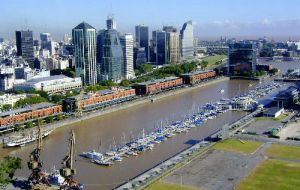MercoPress. South Atlantic News Agency
”Argentina top ten to live in'
 Puerto Madero - Buenos Aires
Puerto Madero - Buenos Aires Argentina for the first time made it to the top ten club that examines the best countries to live in, with France leading for the second year running and war-torn Iraq remaining at the bottom, also for the second year running, according to the latest ranking from International Living magazine.
The publication names Argentina for the best beef in the world, fabulous wines and night life, but the main reason it alleges is that, according to its own estimates, the country is the 11th cheapest in the world. The magazine suggests it as a site for relocating or investing. For eleven months International Living considers the countries where people could live cheaper, pay less tax, enjoy better weather, take advantage of opportunities in emerging markets and places where they can start a new life, a business, start over. This year the survey looked at 193 countries. The complete top ten list this year is made up of France, Australia, Netherlands, New Zealand, United States, Switzerland, Denmark, Italy, Luxembourg, and Argentina. "What happened in Argentina? The period of over-valuation in the 1980s and 1990s devastated the country and discouraged industry and tourism, as other countries nearby priced Argentina out of the market. The people of that big nation watched in disgust as unemployment soared, inflation jumped, industries were decimated, and pensions taken away. In late December 2001, after days of street riots and political unrest, Argentina halted payment on its public debt. The economy went into a tailspin, the magazine said. In a salvation effort, the government devalued the currency. From a peso valued at par to the dollar, Argentina went to one peso worth 19 cents of dollar in January 2002. Since then, the Argentine peso has been gradually creeping up. Now a peso is worth about 32 US cents. On February 25, 2005, Argentina completed the biggest debt restructuring in world history, as investors holding 103 billion dollars in defaulted Argentine debt were asked to accept a government offer to pay back about a third of their original investments. After the deadline lapsed, Argentine stocks immediately soared to a new all-time high in peso terms. Argentina's economy has now grown at a yearly average of about nine percent over the last four years. According to Money Week property prices have risen by 50 percent over the same period, but still cost around a 10th of the price of similar homes in the US or Europe. Buenos Aires is among the world's "brand-name" cities, generously, though understandably, referred to as the Paris of South America. The architecture of Buenos Aires is eclectic. Older classic-style buildings that would be well at home in any European city sit alongside unappealing high rises built in the 1960s, 1970s, and 1980s, as well as, here and there newer and less offensive modern structures. The older apartments in Buenos Aires are much bigger than their European counterparts, making them more comfortable than the typical Continental pied-a-terre. "The typical apartment in Buenos Aires is approximately 3,000 square feet (280 square metre), with three bedrooms, two bathrooms, a large kitchen, sitting room, dining room, and maid's quarters. Compare this with Paris, where a 300-square-foot (28-square-metre) apartment isn't unheard of," International Living said. Furthermore, the per-square-foot cost of these apartments is a third to a 10th that of a similar property in Europe. A 1,000-square-foot (93-square-metre) apartment, for example, in one of these Argentine properties of character will cost about 175,000 to 200,000 dollars right now (about 175 dollars per square foot or 1,900 dollars per square metre). All indications are that an investment in an apartment in Buenos Aires remains a good one, the magazine said. Patagonia is a brand in itself, from Mendoza and its wine region to Bariloche and the lake region, including San Martín de los Andes. Mendoza concentrates the best regions for wineries and vineyard properties, with prices starting as low as 75,000 dollars for a piece of real estate of between 30 to 40 acres (120,000 to 160,000 square metres). A garden city with stunning views of the Andes Mountains, it has five trees for every resident, and its shady avenues impart a relaxing and tranquil pace. The climate is thanks to its location at the foot of the Andes. Mendoza is the fifth-largest wine-producing region in the world. Grapevines were first planted by Jesuit missionaries in 1556. Nearly 80 percent of Argentina's wines are produced here, including Argentina's signature wine, the rich, deep-garnet Malbec, often called Argentina's zinfandel. "Argentina offers a great life as it's supposed to be lived. "We've tried to put our finger on why this is true, exactly. What is it about Argentina that keeps drawing us back?," the magazine asked. "Is it the wonderful food and the long dinners that last for three hours at a stretch? The best beef in the world, fabulous wines and entertainment that goes on into the early hours of the morning? Or is it that, every time we return, we find new sights to see and new places to explore?" "It's all of these things, of course. But, right now, it's primarily that it's so cheap (the 11th cheapest country in the world, according to our Index). "It's hard to go wrong there, whether you are thinking about relocating, or just investing. Now is the time to act." An interesting fact in this year's edition of International Living is that many of the countries that showed the greatest increase from a year ago are from Latin America: Mexico, 25, Uruguay, 28, Panama, 34, Ecuador, 38, Costa Rica, 43, Dominican Republic, 47, Brazil, 48, Chile, 49 and Cuba, 108. Buenos Aires Herald




Top Comments
Disclaimer & comment rulesCommenting for this story is now closed.
If you have a Facebook account, become a fan and comment on our Facebook Page!